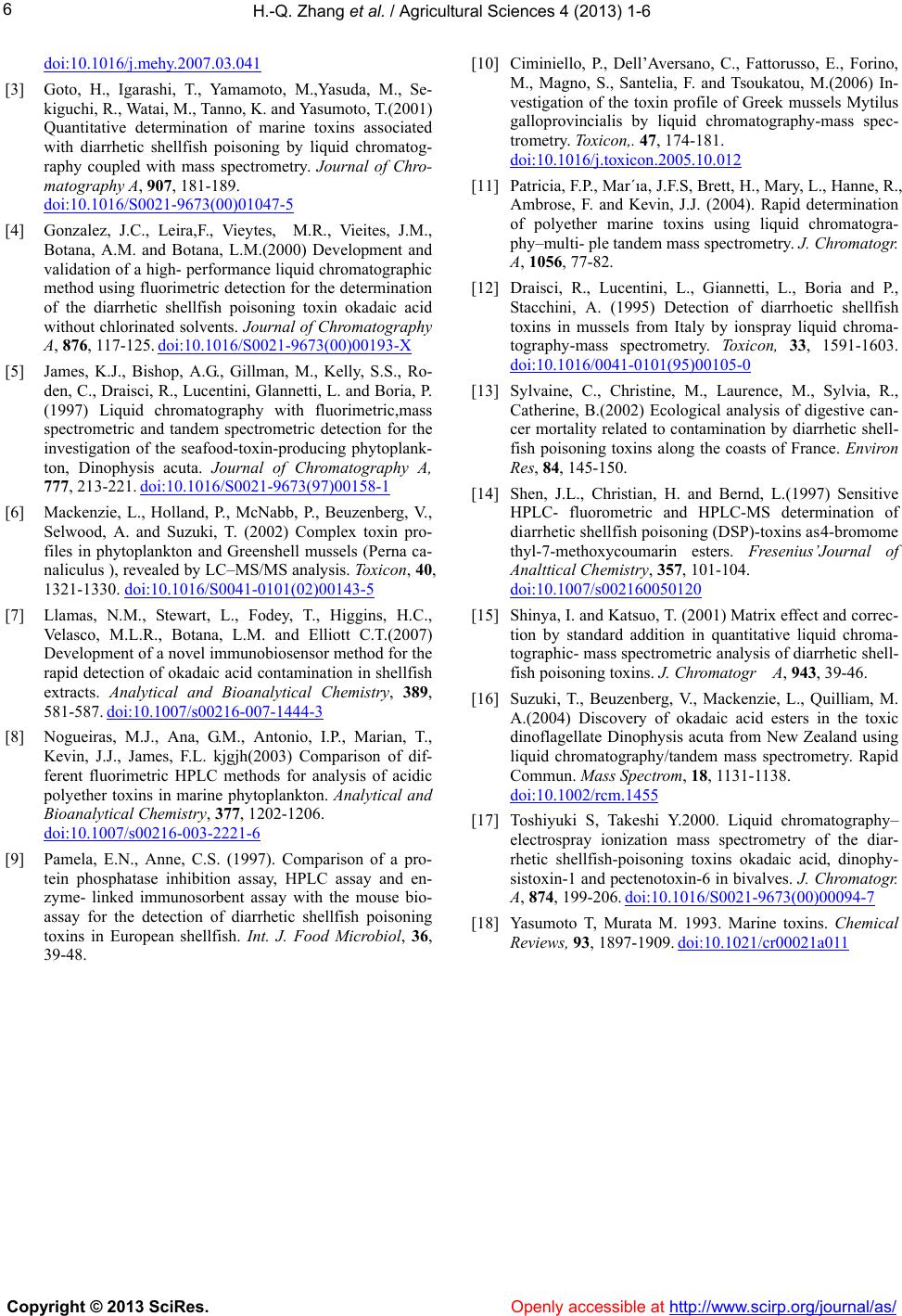
H.-Q. Zhang et al. / Agricultural Sciences 4 (2013) 1-6
Copyright © 2013 SciRes. http://www.scirp.org/journal/as/Openly accessible at
6
doi:10.1016/j.mehy.2007.03.041
[3] Goto, H., Igarashi, T., Yamamoto, M.,Yasuda, M., Se-
kiguchi, R., Watai, M., Tanno, K. and Yasumoto, T.(2001)
Quantitative determination of marine toxins associated
with diarrhetic shellfish poisoning by liquid chromatog-
raphy coupled with mass spectrometry. Journal of Chro-
matography A, 907, 181-189.
doi:10.1016/S0021-9673(00)01047-5
[4] Gonzalez, J.C., Leira,F., Vieytes, M.R., Vieites, J.M.,
Botana, A.M. and Botana, L.M.(2000) Development and
validation of a high- performance liquid chromatographic
method using fluorimetric detection for the determination
of the diarrhetic shellfish poisoning toxin okadaic acid
without chlorinated solvents. Journal of Chromatography
A, 876, 117-125. doi:10.1016/S0021-9673(00)00193-X
[5] James, K.J., Bishop, A.G., Gillman, M., Kelly, S.S., Ro-
den, C., Draisci, R., Lucentini, Glannetti, L. and Boria, P.
(1997) Liquid chromatography with fluorimetric,mass
spectrometric and tandem spectrometric detection for the
investigation of the seafood-toxin-producing phytoplank-
ton, Dinophysis acuta. Journal of Chromatography A,
777, 213-221. doi:10.1016/S0021-9673(97)00158-1
[6] Mackenzie, L., Holland, P., McNabb, P., Beuzenberg, V.,
Selwood, A. and Suzuki, T. (2002) Complex toxin pro-
files in phytoplankton and Greenshell mussels (Perna ca-
naliculus ), revealed by LC–MS/MS analysis. Toxicon, 40,
1321-1330. doi:10.1016/S0041-0101(02)00143-5
[7] Llamas, N.M., Stewart, L., Fodey, T., Higgins, H.C.,
Velasco, M.L.R., Botana, L.M. and Elliott C.T.(2007)
Development of a novel immunobiosensor method for the
rapid detection of okadaic acid contamination in shellfish
extracts. Analytical and Bioanalytical Chemistry, 389,
581-587. doi:10.1007/s00216-007-1444-3
[8] Nogueiras, M.J., Ana, G.M., Antonio, I.P., Marian, T.,
Kevin, J.J., James, F.L. kjgjh(2003) Comparison of dif-
ferent fluorimetric HPLC methods for analysis of acidic
polyether toxins in marine phytoplankton. Analytical and
Bioanalytical Chemistry, 377, 1202-1206.
doi:10.1007/s00216-003-2221-6
[9] Pamela, E.N., Anne, C.S. (1997). Comparison of a pro-
tein phosphatase inhibition assay, HPLC assay and en-
zyme- linked immunosorbent assay with the mouse bio-
assay for the detection of diarrhetic shellfish poisoning
toxins in European shellfish. Int. J. Food Microbiol, 36,
39-48.
[10] Ciminiello, P., Dell’Aversano, C., Fattorusso, E., Forino,
M., Magno, S., Santelia, F. and Tsoukatou, M.(2006) In-
vestigation of the toxin profile of Greek mussels Mytilus
galloprovincialis by liquid chromatography-mass spec-
trometry. Toxicon,. 47, 174-181.
doi:10.1016/j.toxicon.2005.10.012
[11] Patricia, F.P., Mar´ıa, J.F.S, Brett, H., Mary, L., Hanne, R.,
Ambrose, F. and Kevin, J.J. (2004). Rapid determination
of polyether marine toxins using liquid chromatogra-
phy–multi- ple tandem mass spectrometry. J. Chromatogr.
A, 1056, 77-82.
[12] Draisci, R., Lucentini, L., Giannetti, L., Boria and P.,
Stacchini, A. (1995) Detection of diarrhoetic shellfish
toxins in mussels from Italy by ionspray liquid chroma-
tography-mass spectrometry. Toxicon, 33, 1591-1603.
doi:10.1016/0041-0101(95)00105-0
[13] Sylvaine, C., Christine, M., Laurence, M., Sylvia, R.,
Catherine, B.(2002) Ecological analysis of digestive can-
cer mortality related to contamination by diarrhetic shell-
fish poisoning toxins along the coasts of France. Environ
Res, 84, 145-150.
[14] Shen, J.L., Christian, H. and Bernd, L.(1997) Sensitive
HPLC- fluorometric and HPLC-MS determination of
diarrhetic shellfish poisoning (DSP)-toxins as4-bromome
thyl-7-methoxycoumarin esters. Fresenius’Journal of
Analttical Chemistry, 357, 101-104.
doi:10.1007/s002160050120
[15] Shinya, I. and Katsuo, T. (2001) Matrix effect and correc-
tion by standard addition in quantitative liquid chroma-
tographic- mass spectrometric analysis of diarrhetic shell-
fish poisoning toxins. J. Chromatogr A, 943, 39-46.
[16] Suzuki, T., Beuzenberg, V., Mackenzie, L., Quilliam, M.
A.(2004) Discovery of okadaic acid esters in the toxic
dinoflagellate Dinophysis acuta from New Zealand using
liquid chromatography/tandem mass spectrometry. Rapid
Commun. Mass Spectrom, 18, 1131-1138.
doi:10.1002/rcm.1455
[17] Toshiyuki S, Takeshi Y.2000. Liquid chromatography–
electrospray ionization mass spectrometry of the diar-
rhetic shellfish-poisoning toxins okadaic acid, dinophy-
sistoxin-1 and pectenotoxin-6 in bivalves. J. Chromatogr.
A, 874, 199-206. doi:10.1016/S0021-9673(00)00094-7
[18] Yasumoto T, Murata M. 1993. Marine toxins. Chemical
Reviews, 93, 1897-1909. doi:10.1021/cr00021a011